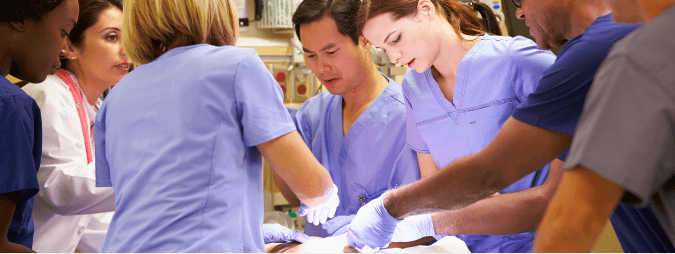In The Initial Trauma Assessment Part 1 we looked at the primary survey as advocated by the ATLS program and the ‘ABDCE’ approach to the initial assessment of the patient.
Once the primary survey has been completed, resuscitative efforts are underway, and the patient’s vital functions have been normalised, the next stage in the initial evaluation of the trauma patient is to perform the secondary survey.
What is the secondary survey?
The secondary survey is a head-to-toe evaluation of the trauma patient and involves taking a thorough history and performing a comprehensive examination. This should be painstakingly performing, as missing or under appreciating the significance of an injury can be potentially catastrophic. Further investigations, including X-rays, scan and blood work may also be necessary during this stage of the evaluation.
The history
It is of key importance to obtain a detailed history from the patient. The patient should be asked about the mechanism of injury, as this will greatly influence their clinical condition. Certain injuries can be predicted based on the direction and amount of energy behind the mechanism of injury. The injury is usually classified into one of two broad categories, blunt and penetrating injury, and this will further influence ongoing management.
It is sometimes not possible to obtain a history from the patient due to their clinical condition, and in these circumstances, you should attempt to gather as much information as possible from the pre-hospital team, family members, and any witnesses that were present.
The ‘AMPLE’ history is a very useful mnemonic for taking a rapid yet thorough, patient history in the trauma setting:
- Allergies
- Medications currently used
- Past illnesses/Pregnancy
- Last meal
- Events/Environment related to the injury
Once the history has been obtained, the detailed head-to-toe-examination can be commenced.
HEENT examination
The examination should start at the head and work down the body towards the feet. The first step is to examine the head, eyes, ears, nose, and throat (HEENT).
The scalp should be examined for wounds and bleeding, and the scalp, face, and jaw should be palpated for bony tenderness. The Glasgow Coma Scale (GCS) score should be repeated at this stage and the pupils inspected for size, symmetry and reaction to light.
The ears should be examined looking at the mastoid for Battle’s sign, and at the tympanic membrane for evidence of haemotympanum. It is also important to examine the nose for evidence of septal haematoma and to examine the oral cavity for dental alignment and broken teeth.
The cervical spine
If the patient is immobilised in a cervical collar, then an assistant should be present to maintain spinal precautions during removal of the collar. Following removal of the collar, the spine should be examined for midline tenderness and the need for cervical spine imaging assessed accordingly.
There are a number of validated tools available to assist in this assessment, including the Canadian C-Spine rule and the NEXUS criteria.
The thorax
The shoulder girdle should be inspected for external injuries and palpated for tenderness and instability. The chest wall should be re-examined thoroughly and any injuries detected during the primary survey re-inspected. The ribs should be palpated one by one, looking for bony tenderness and/or instability.
At this stage, the chest should also be re-auscultated and a cardiovascular examination performed.
The abdomen and pelvis
The abdomen and pelvis should be re-inspected, looking for evidence of bruising or external injuries. The abdomen should then be palpated for tenderness, guarding, and rebound tenderness.
The pelvis should be gently palpated for evidence of bony tenderness or instability. Excessive manipulation of the pelvis should be avoided, as this can precipitate or worsen haemorrhage associated with a pelvic fracture. An AP pelvic X-ray should be taken as an adjunct if there is any concern about the presence of a pelvic injury.
The perineum, rectum, and vagina
The perineum should be inspected for the presence of bruising, haematomas, lacerations, and urethral bleeding.
A rectal examination may be performed before the placement of a urethral catheter, looking for the presence of blood within the rectum, a high-riding prostate, evidence of pelvic fractures, and anal sphincter tone.
A vaginal examination should be performed in all women at risk of vaginal injury, including those with suspected or confirmed pelvic fractures. In addition, a pregnancy test should be performed on all women of childbearing age.
The musculoskeletal system
All extremities should be inspected, looking for the presence of bruising, lacerations, and obvious deformities. All the bones should be palpated for evidence of tenderness and the range of movement of the joints assessed. This should include an examination of the small bones of the hands and feet, as these fractures can be easily missed.
The back
The patient should be log rolled with assistance, maintaining spinal precautions if necessary. The back should then be inspected for evidence of bruising, haematomas, and lacerations. Each spinous process should be palpated in turn, looking for bony tenderness and steps or instability. A digital rectal examination is often performed at this stage, although the need for this has been questioned in recent times.
The neurological system
To complete the secondary survey, a comprehensive neurological examination should be performed, adding to the earlier examination of the patient’s level of consciousness and pupils. This should include a detailed motor and sensory evaluation of the patient’s extremities.
Record-keeping
It is vitally important to keep meticulous notes throughout the initial trauma assessment. A dedicated scribe is an important and often overlooked member of the trauma team. This has not only clinical implications but also legal considerations.
Header image used on licence from Shutterstock
Thank you to the joint editorial team of www.mrcemexamprep.net for this article.







This is simple but thorough.
I have loved it